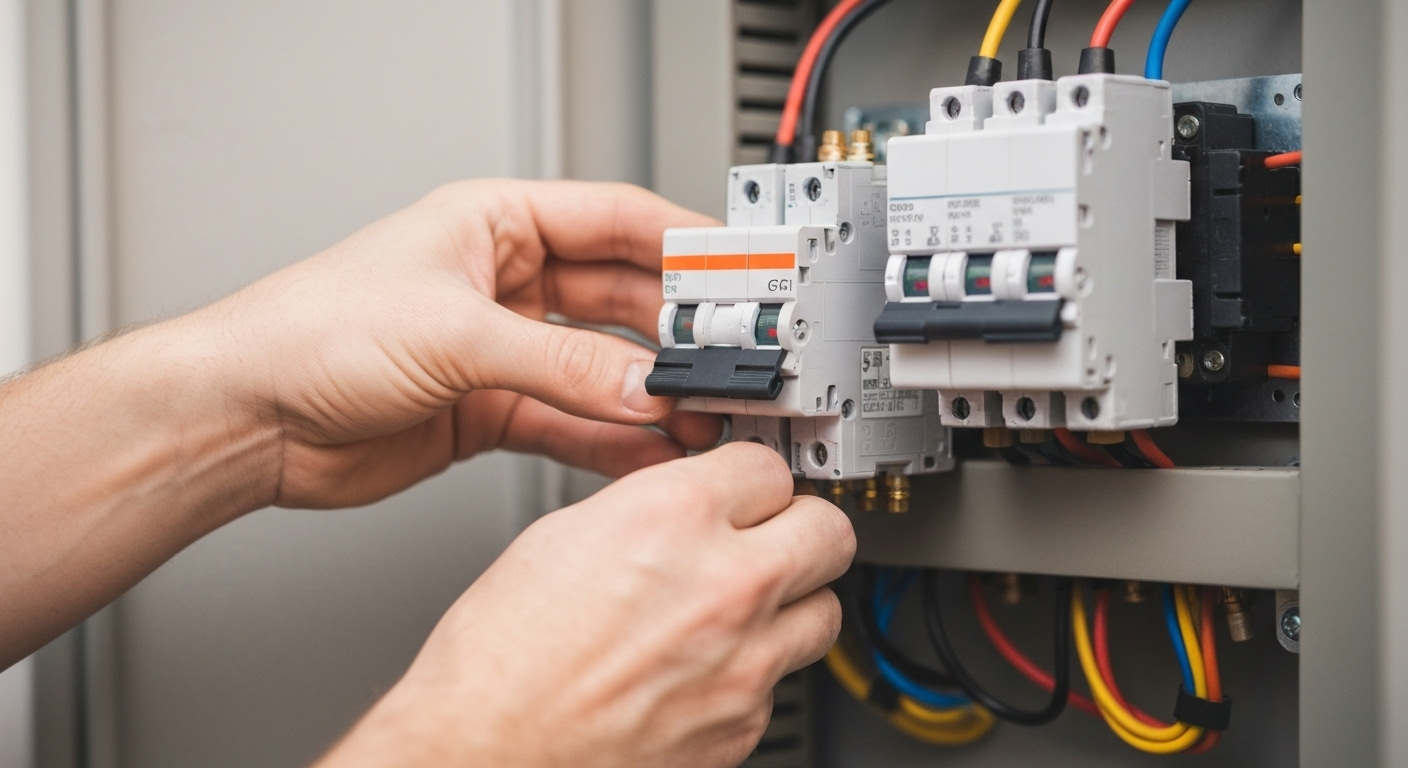
Understanding NEC 2023 GFCI Rule Changes (Section 210.8 Explained)
The Bottom Line: What Are the New NEC 2023 GFCI Requirements?
The NEC 2023 GFCI requirements in Section 210.8 represent a significant expansion of personnel protection, moving beyond the familiar 15- and 20-ampere receptacle rules. The most critical change is the new voltage-based requirement: GFCI protection is now mandatory for all 125-volt through 250-volt receptacles supplied by single-phase branch circuits rated 150 volts or less to ground in specified locations. This replaces the previous amperage-based language. Furthermore, NEC 2023 broadens the scope of GFCI protection in both dwelling units (210.8(A)) and other than dwelling units (210.8(B)), notably including any area that meets the strict definition of a kitchen. The most substantial new addition is Section 210.8(F) Outdoor Outlets, which mandates GFCI protection for all outdoor outlets—not just receptacles—including hard-wired equipment, on branch circuits rated 150 volts to ground or less and 50 amperes or less. Compliance requires a deep understanding of these expanded locations and voltage/amperage parameters.
A Master Electrician’s Guide to NEC Section 210.8
As a certified CE instructor, I’ve seen firsthand how Code changes can create confusion on the job site. The updates to NEC 210.8 (GFCI Protection for Personnel) in the 2023 cycle are some of the most impactful we’ve seen, directly affecting daily installation practices. These aren’t minor tweaks; they are foundational shifts in how we protect people from electrical shock hazards.
For decades, Ground-Fault Circuit-Interrupter (GFCI) protection has been a cornerstone of electrical safety. The tireless work of Code Making Panel 2 (CMP-2) continues to refine these rules based on incident data and evolving technology. The 2023 changes reflect a clear intent to close loopholes and extend protection into areas previously left uncovered. Let’s break down what you, the professional electrician, need to know to ensure every installation is safe and compliant.
Key Changes in NEC 2023 Section 210.8
The core of the NEC 2023 vs 2020 changes for GFCIs lies in three areas: the shift from amperage to voltage, the expansion of locations in both dwelling and non-dwelling units, and the introduction of a brand-new rule for all outdoor outlets.
Expanded Voltage Range: 125-Volt Through 250-Volt Receptacles
Perhaps the most sweeping change is the revision of the introductory text in 210.8(A) and (B). The 2020 NEC specified GFCI protection for “125-volt, single-phase, 15- and 20-ampere receptacles.”
The 2023 NEC now requires that GFCI protection be provided for all 125-volt through 250-volt receptacles installed in the specified locations and supplied by single-phase branch circuits rated 150 volts or less to ground.
This means that 30-amp or 50-amp, 240-volt receptacles for dryers or ranges in a basement, laundry area, or garage now require GFCI protection. This is a critical update for anyone installing appliance GFCI requirements and will likely necessitate more two-pole GFCI circuit breakers.
210.8(A) Dwelling Units: New Locations and Clarifications
Section 210.8(A) for Dwelling Units has expanded its reach. While familiar locations like bathrooms and garages remain, the 2023 code clarifies and expands protection, notably through an updated definition in Article 100:
- (A)(6) Kitchens: The scope of this subsection is impacted by the Article 100 definition of “Kitchen,” which is “An area with a sink and permanent provisions for food preparation and cooking.” This is not a new subsection, but the precise definition is crucial. An area must have all three components—a sink, a means for food prep, and a means for cooking—to be defined as a kitchen and fall under this rule.
- (A)(7) Sinks: GFCI protection is now required for all receptacles installed within 6 ft. of the top inside edge of the bowl of any sink. This clarifies the requirement for sinks located in areas that might not be a kitchen or bathroom.
210.8(B) Other Than Dwelling Units: A Broader Scope for Commercial Work
The rules for non-dwelling locations in 210.8(B) saw similar, if not greater, expansion. In addition to the voltage change, the list of locations has been clarified:
- (B)(2) Kitchens: Similar to dwelling units, the official Article 100 definition of “Kitchen” now applies here: “An area with a sink and permanent provisions for food preparation and cooking.” This means commercial areas that meet this strict three-part definition now require GFCI protection on all 125V-250V receptacles. This is not a new, separate subsection but an expansion of an existing rule’s application.
- (B)(5) Sinks: GFCI is required for receptacles within 6 ft. of the top inside edge of the bowl of a sink.
- (B)(13) Aquariums, Bait Wells, and Similar Equipment: This rule now explicitly requires GFCI for receptacles supplying this equipment in commercial settings, a logical extension of safety near water.
These changes reinforce the NEC’s principle: the hazard exists wherever electricity and water can mix, regardless of the building’s classification.
The Big One: 210.8(F) Outdoor Outlets
This is arguably the most significant addition to Section 210.8. The new Section 210.8(F) Outdoor Outlets states:
“All outdoor outlets for dwellings, other than those covered in 210.8(A)(3), Exception to (3), that are supplied by single-phase branch circuits rated 150 volts to ground or less, 50 amperes or less, shall be provided with GFCI protection.”
The key word here is “outlets,” not “receptacles.” An outlet is defined in Article 100 as a point on the wiring system where current is taken to supply utilization equipment. This includes hard-wired equipment like mini-split heat pumps, pool pump motors, and landscape lighting transformers. This new rule aims to prevent shocks from equipment with damaged insulation or internal faults in outdoor, wet environments.
Step-by-Step: Applying the New 210.8(F) Outdoor Outlet Rule
Determining if GFCI is required for an outdoor installation under 210.8(F) can be done systematically. Follow this process for every outdoor outlet you install at a dwelling unit.
- Identify the Outlet Type: Is it a receptacle or a hard-wired connection point (e.g., a disconnect or junction box for an AC unit)? Under 210.8(F), it doesn’t matter. Both are considered “outlets.”
- Check the Voltage and Phase: Is the branch circuit single-phase and rated 150 volts to ground or less? For most residential systems, a 120V or 240V single-phase circuit meets this condition.
- Verify the Amperage: Is the branch circuit’s overcurrent protective device (OCPD) rated 50 amperes or less? If you are running a 30A circuit to a mini-split or a 20A circuit to a pool pump, it falls under this rule. A 60A circuit to a large condenser unit would not.
- Review Exceptions: Check if the outlet meets the specific exception criteria referenced in 210.8(F). The exception, located at 210.8(A)(3), Exception to (3), applies to a receptacle that is not readily accessible and is supplied by a dedicated branch circuit for electric snow-melting, deicing, or pipeline and vessel heating equipment. This is a very specific and rare exception.
- Install GFCI Protection: If the conditions in steps 1-3 are met and no exception applies, you must provide GFCI protection. This can be a GFCI circuit breaker or another listed GFCI device, but it must be in a readily accessible location for reset.
Key Considerations for Electrical Inspection Compliance
Navigating these new NEC 2023 GFCI requirements means being prepared for inspections. Keep these points in mind to avoid red tags and project delays.
- Nuisance Tripping Concerns: The expansion to 250-volt appliances and outdoor motors has raised concerns about nuisance tripping. It’s crucial to use high-quality, properly rated equipment. For motors, a “soft start” can sometimes mitigate inrush currents that cause trips. Inform your clients about the possibility and the safety reasons behind the code.
- Readily Accessible Location: GFCI devices, whether breakers or receptacles, must be readily accessible. Installing a GFCI breaker for a rooftop AC unit in an electrical panel in the basement is compliant. Placing a GFCI receptacle behind a non-movable appliance is not.
- Dual-Function AFCI/GFCI Devices: With many of these newly required GFCI locations also requiring AFCI protection (e.g., dwelling unit kitchens, laundry areas), using dual-function AFCI/GFCI circuit breakers is often the most efficient path to compliance. It’s essential to understand where both are required. Our state approved continuing education lessons such as how nec updated gfci requirements. can help clarify these overlapping rules.
- Tamper-Resistant Receptacles: Remember that GFCI requirements are in addition to other codes. In locations requiring tamper-resistant receptacles (406.12), you must use a device that is both GFCI protected and tamper-resistant.
Mastering the nuances of these GFCI updates is non-negotiable for professional electricians. To dive deeper and stay current with all the other critical revisions, you can learn more with ExpertCE’s NEC 2023 lessons. Our courses are designed by electricians, for electricians, to make complex code simple and applicable in the field.
Primary Sources & Further Reading
For official text and interpretations, always refer to the primary source documents. This article is for instructional purposes and is not a substitute for the official codebook.
- NFPA 70, National Electrical Code (NEC), 2023 Edition
- Your State or Local Electrical Licensing Board for specific amendments.
Frequently Asked Questions (FAQ)
What are the main NEC 2023 GFCI requirements?
The main NEC 2023 GFCI requirements expand GFCI protection to all 125-volt through 250-volt receptacles in specified locations, replacing the old 15- and 20-amp limit. It also broadens the list of locations in both dwelling and non-dwelling units, such as any area with a sink. Finally, it adds Section 210.8(F), mandating GFCI for most outdoor outlets (not just receptacles) rated 50 amps or less at a dwelling.
Does NEC 210.8(B) now apply to all receptacles in a commercial kitchen?
Yes, for the most part. NEC 210.8(B)(2) requires GFCI for kitchens in other-than-dwelling units. The 2023 update to the parent text of 210.8(B) means this applies to 125-volt through 250-volt receptacles. Therefore, a 240V receptacle for an oven or a 120V/30A receptacle for a mixer would now require GFCI protection, which is a significant change from the 2020 code.
Why did the NEC change GFCI rules for outdoor outlets in 2023?
The new rule in 210.8(F) for outdoor outlets was driven by data showing shock and electrocution incidents involving hard-wired outdoor equipment, like HVAC units and pool pumps. Code Making Panel 2 determined that the risk of shock from deteriorating equipment insulation in a wet outdoor environment was high, regardless of whether the connection was a receptacle or a hard-wired outlet. The 50-amp limit was set to target common residential equipment while excluding larger service-entrance or feeder-supplied equipment.
Can I use a GFCI circuit breaker instead of a GFCI receptacle?
Absolutely. The NEC requires GFCI protection but does not mandate the method. Using a GFCI circuit breaker is a very common and effective way to protect an entire branch circuit, including all downstream receptacles and hard-wired outlets. This is often the most practical solution for complying with the new 250-volt receptacle and 210.8(F) outdoor outlet rules. The key is that the reset function must be in a readily accessible location.
Continuing Education by State
Select your state to view board-approved continuing education courses and requirements:
Disclaimer: The information provided in this educational content has been prepared with care to reflect current regulatory requirements for continuing education. However, licensing rules and regulations can vary by state and are subject to change. While we strive for accuracy, ExpertCE cannot guarantee that all details are complete or up to date at the time of reading. For the most current and authoritative information, always refer directly to your state’s official licensing board or regulatory agency.



